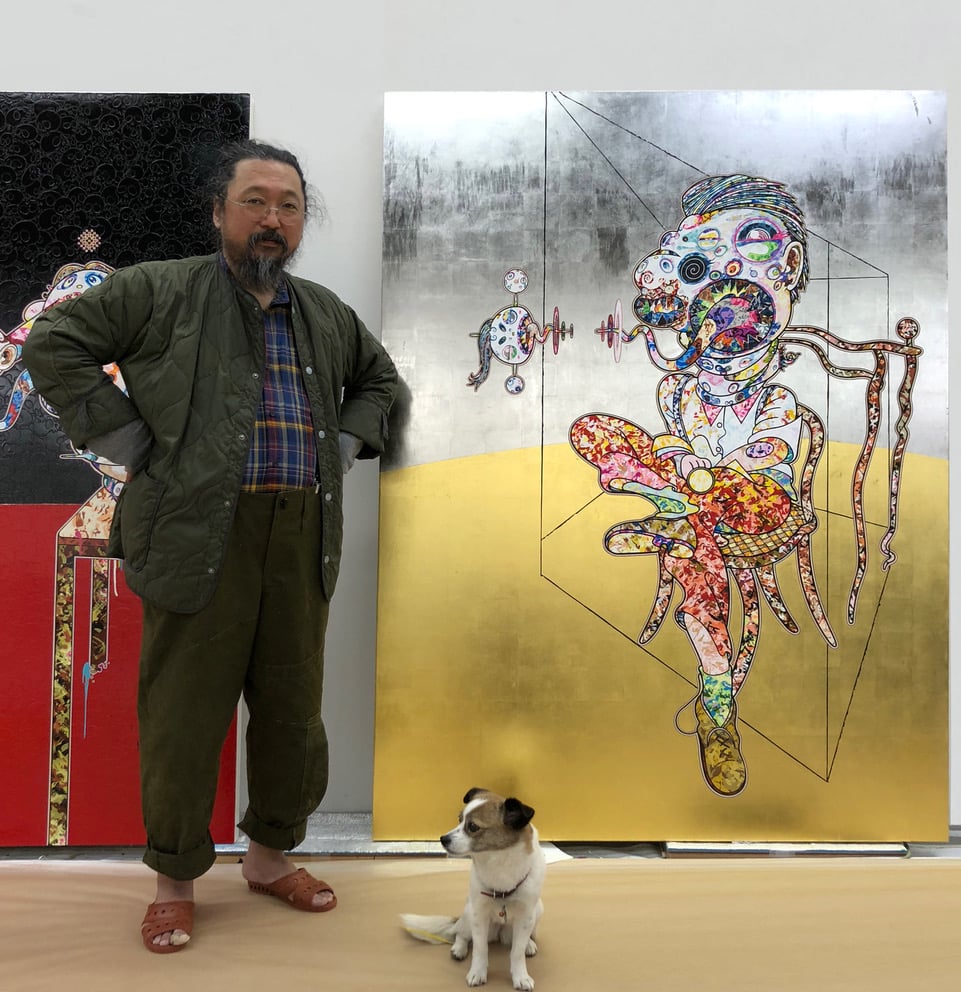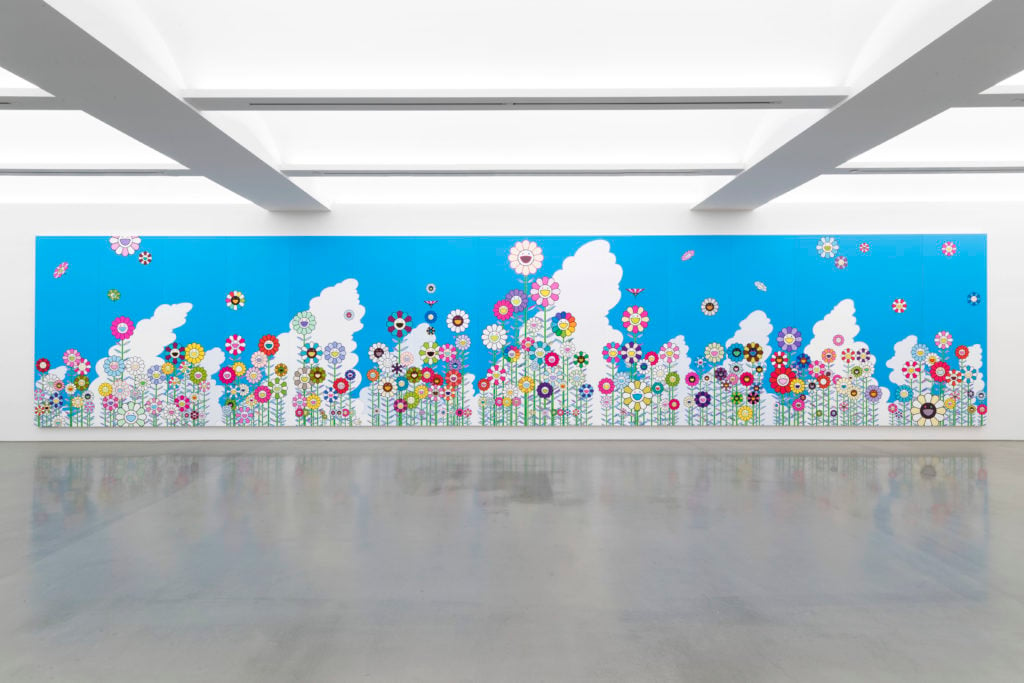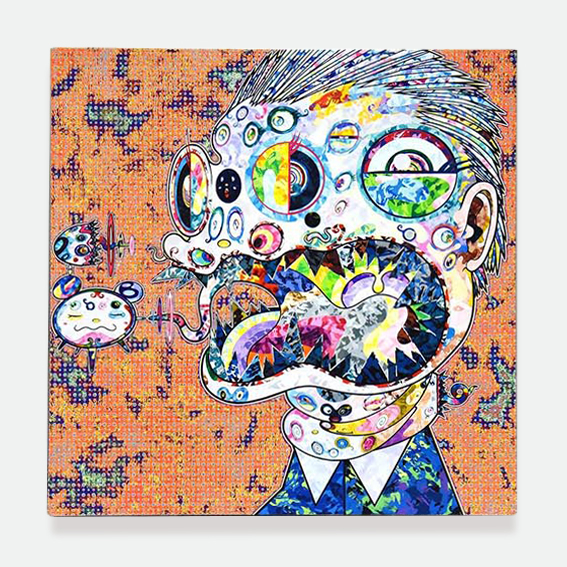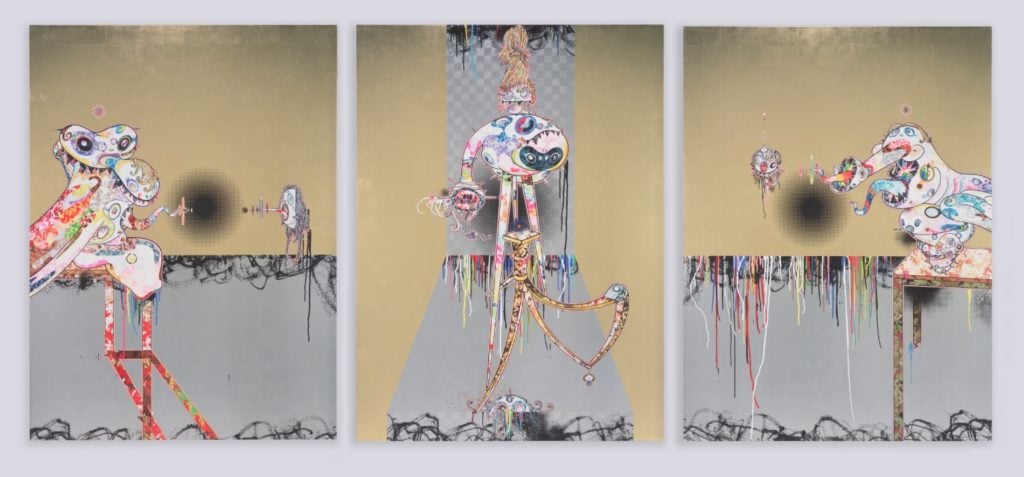Art World
Beyond Daisies and Kitsch: An Older, Wiser Takashi Murakami Opens Up in a Candid Q&A
The world-famous artist on his technology-enabled evolution, the lessons of Willem de Kooning, and the inescapable end of everything.

The world-famous artist on his technology-enabled evolution, the lessons of Willem de Kooning, and the inescapable end of everything.

Takashi Murakami is not the artist you think he is. Not exactly, anyway. Although his signature superflat style has electrified everything from major international museum exhibitions to Louis Vuitton bags to Kanye West album covers since he minted the term almost two decades ago, it’s fair to say that Murakami, the brand, has somewhat overwhelmed Murakami, the man.
In some sense, this was to be expected. Successful brands grow out of iconic founders, and few contemporary artists have reached the cross-platform visibility that Murakami has in this generation.
But icons by definition cease to be layered human beings in the popular imagination. Very few people who ever laced up a pair of Jordans wonder about how advances in training technology might have affected Michael’s approach to his jump shot, let alone what the middle-aged legend’s perspective on mortality might be. They look at the man and just see a logo.
“Heads ↔ Heads,” Murakami’s new exhibition of paintings at Perrotin New York (on view through June 17), shifts the conversation. The show features works ranging from intimate preparatory sketches to monumental gilt-and-platinum canvases. And while Murakami’s well-known flowers proliferate through the gallery’s ground floor, the upper levels center on his series Homage to Francis Bacon, as well as his own epic reinterpretation of pioneering 18th-century Japanese artist Soga Shohaku’s folding screen Transcendent Attacking a Whirlwind.
A few hours before the exhibition opened to the public, Murakami sat down with artnet News (and a translator) to discuss technology, death, and art history.

Takashi Murakami’s Transcendent Attacking a Whirlwind (2017).©2017 Takashi Murakami/Kaikai Kiki Co., Ltd. All Rights Reserved. Courtesy Perrotin.
Your recent exhibitions seem to focus much more on tying your practice in with both Western and Eastern art history. “Heads ↔ Heads” obviously includes your take on Francis Bacon and Soga Shohaku. I know that you have a deep background with past greats, going back to seeing works by Van Gogh and Goya as a child. Why have you made such a strong choice to bring these other artists into your work directly lately?
It’s not that I’ve been suddenly making all these works. I have been making works emulating ink paintings like Shohaku’s for years now. And I’ve done the Homage to Bacon series for more than 10 years.
But when I started them, I would make only one or two works and then stop.
The reason why I’ve been making so many at once now is because I feel like I’ve finished digesting and sort of installing within me what the forms of Bacon paintings are, or what these historical paintings are. I know what Bacon means to me, or how the form operates. And for example, the Japanese traditional paintings and religious paintings—all the characters and scene settings have backgrounds and history. I’ve been digesting them, and now the environment is ready for me to produce them.
So these elements have been in the background in the past, and now you feel capable of putting them more in the foreground because you fully understand them and how they relate to you.
I feel like the tendency for people to perceive a painting is, “OK, one artist paints a painting.” As if the condition remains the same ten years ago, three years ago, and now. But I work with computers, and I work with assistants, and the way I create the work constantly evolves. Especially in the past few years, we’ve been able to use a lot of the 3D modeling programs, so the way I can grasp and understand forms has drastically changed and evolved.
It seems as though lately you’ve also been much more open and willing to engage themes like religion and mortality. You’ve also talked in the past about how some of the art forms that your work is most often associated with—anime and manga, for instance—grow out of Japanese postwar fears of nuclear annihilation and other more serious issues. Similar to what we were just talking about with forms, were those themes always lurking in the background of your earlier work, and now you’re trying more consciously to put them forward?
Like I was saying, artistic expression really has to do with technique, and how you can actually realize ideas. For example, Frank Gehry: Once the computer started evolving, and he could use it more freely, then his forms started morphing more drastically. I think those forms were always in his head, but until the technology really caught up with him, he couldn’t realize them in his work.
In the same way, I have been painting flowers for years, and people say, “They’re happy, happy!” But I never explained what they really are. Smiles and laughter always have different layers to them, too. The only reason they were simple is that, technically, I could only paint simple things.
But with the evolution of technique and technology, I have been able to more directly express the emotions and feelings over time. I think the 3D modeling programs especially are what revolutionized the way I can express these things.

Takashi Murakami’s “Heads ↔ Heads,” Perrotin New York exhibition view. All artwork © Takashi Murakami/Kaikai Kiki Co., Ltd. All Rights Reserved. Courtesy Perrotin. Photo: Guillaume Ziccarelli.
Do you feel like your audience understands how much technology ends up playing into your paintings?
It’s totally fine that they don’t. Because if I’m playing a video game, I don’t know anything about the gaming technology.
You’ve spoken in other interviews about how you feel your work won’t be fully understood until many years after you’re gone. Given what you’ve just said about technology and how it doesn’t necessarily matter if your audience understands its role in your work, is there a contradiction there? Would it help people understand these more layered ideas if they had a fuller understanding of how your works are made?
I don’t think it contradicts at all. A good example is Warhol, right? When he was still around, maybe he would screenprint, maybe his assistant would screenprint, but either way, the work is just a one-time screenprint, and then it’s done. Maybe the people who were watching were thinking, “Is this really art? It’s so simple…”
But then once he’s dead, and the assistants who were doing the printing are gone, then there’s nothing there. So then people would think, “What was Warhol thinking when he was doing the printing? What was the meaning of it? Why were these works coming about?” So people have space to actually think about what motivated the works.
In a similar way, after I’m done, if interested people are reading interviews or looking at bodies of work, they might think, “Why was he making so many works like this? Why could he make so many works during this period?” And then they can also see the transformation of works and themes and styles from period to period, right?
I don’t think that everyone needs to understand what I’m doing now, or how I’m doing it, and not everyone needs to understand it after I’m gone. The people who are actually interested in it can explore this kind of mysteriousness after the fact.
So people now tend to be too focused on the technique and the production. And over time they’ll be able to focus more on the motivations and themes.
It’s not that I’m dividing technique and theme and motivation. It’s all mixed together. All I’m saying is that in the moment when the artist is still alive and around, there is a lot of noise. There are a lot of things that distract you. But once they’re gone, there’s something pure that they can explore.
(At this point, Murakami bypasses his translator and begins answering questions directly in English.)
You are young.
(Laughter) I’m older than I look. I’m 35!
(in English): Yes, but you are very young. That’s why you can’t imagine yet.
Aging is a good thing and a very sad thing. When we go to the museum, almost every one of the artists has died. We’re watching for a message sung from death. But when I was young, I could not imagine this desperation in the museum. It looks like talking with living artists, because painting and sculpture are still alive. But the artists themselves have passed away.

Takashi Murakami’s Homage to Francis Bacon (Study for Head of George Dyer (on light ground)) (2018). ©2018 Takashi Murakami/Kaikai Kiki Co., Ltd. All Rights Reserved. Courtesy Perrotin.
How do you think that change in perspective has affected your work, then—that awareness of time and history you didn’t have when you were younger?
I think now I can get much more freedom. My goal, my hope, is to go the Cy Twombly way, or the Willem de Kooning way. When de Kooning was young, he did very complex paintings. When he got Alzheimer’s, his paintings had much more freedom. Maybe he was struggling, forgetting things, confusing things. But for the audience, there was really much more freedom. So I think for me now it is, step by step, more freedom in making the pieces.
A lot of very young artists are just interested in making a nice painting. But as they age, these artists have to start training every day. It’s like meditation, like a monk. And then they find out the very simple question and answer. They go to the canvas and put down a brushstroke or something. And suddenly the audience can understand it.
A Picasso painting looks like it has no ideas in it. It really looks like freedom. What is Cubism? It’s just, “Aaah, I love beautiful women. I love the freedom feeling. I want to eat something. [satisfied sigh] Aaah…” (laughter) This is freedom, right? So if I can get something like that feeling in the future, it is a great thing.
We’re talking about painting now, but obviously you work in many different media, whether it’s filmmaking or even some of the collaborations you’ve done with Louis Vuitton or other brands. Are you going after that same simplicity in all of those forms now?
Painting is my profession. But I still love making film, because I can learn a lot from that process—for example, about human resources, the system, how to move each different person psychologically. For computer graphics animation, sometimes I’ve [collaborated with] over 100 people. Each person is an artist, a creator. So if I just say something like (shifts into imposing voice), “You have to do it this way,” they cannot move. Communicating is a really difficult process—and feedback, too.
Collaboration is mostly a fun time, because I can get in touch with other artists and have a very intellectual experience. It’s like going into another artist’s brain, as another artist comes into my brain—very deep communication, brain to brain.

Takashi Murakami’s Homage to Francis Bacon (Second Version of Triptych (on light ground)) (2016). ©2016 Takashi Murakami/Kaikai Kiki Co., Ltd. All Rights Reserved. Courtesy Perrotin.
Collaboration has been a big part of your practice for a long time. You’ve talked very openly in the past about how you see your relationship to your assistants as a kind of classical Japanese apprentice-master relationship. Do you think that changes when you’re working in these other media like computer graphics or film? Do you feel like you are less “the master” in that situation?
(Murakami returns to answering in Japanese through his translator.)
Yes, definitely, it has been changing. In the past, early on, I saw myself as the head of the operation and I was ordering around young people. And I used to get really harshly criticized for using other, younger people to do what they saw as my work. Still today, when I put up images of my assistants working on my paintings on Instagram, I get a lot of people saying, “Why don’t you make your own work?” But what they don’t understand is that I’m doing all these other types of work. For people who are just doing the simple labor part of it, it’s difficult to understand what my labor is.
But I have a much better understanding of it, because in making a film, you work with actors as well as the camera people, the set designers. Without the director having a clear vision to communicate to these other visual creators, they can’t move effectively. I really have to think about how to communicate my vision in a way that they can grasp.
So even though I still get criticized for the way I’m making artwork, that’s kind of misplaced. I see it differently. It all happens in a director’s mind.